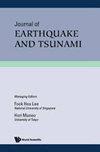基于微震观测的抗震加固效果定量评价
IF 2.1
4区 工程技术
Q2 GEOCHEMISTRY & GEOPHYSICS
引用次数: 0
摘要
为了定量地验证建筑物的抗震改造,我们观察了京都大学宇治校区建筑物的微震。我们比较了五层钢框架结构和三层钢筋混凝土(RC)建筑在改造前后的微震谐振频率的动力特性。我们根据改造设计方案计算了建筑物的重量,并通过估计符合共振频率的建筑物刚度建立了结构的数值模型。假设从以前的研究中得到的数值模型的每一层的恢复力的特征,我们计算了建筑物对强运动的非线性响应,预测发生在Uji校园正前方的Obaku断层系统的地震。对比了加固前后数值模型的响应,验证了加固的效果。我们发现,当钢筋结构与现有结构刚性固定时,采用微震观测建立动力响应模型的方法是有效的,对于钢筋混凝土建筑也是如此。本文章由计算机程序翻译,如有差异,请以英文原文为准。
Quantitative Evaluation of the Seismic Reinforcement Effect Based on Observed Microtremors
To validate the seismic retrofitting of buildings quantitatively, we observed microtremors in the Uji campus buildings at Kyoto University. We compared the dynamic characteristics derived from the resonant frequency of microtremors in a five-story steel-frame structure and a three-story reinforced-concrete (RC) building before and after retrofitting. We calculated the weight of the building from the retrofitting design plan and constructed a numerical model of the structure by estimating the building stiffness that fits the resonant frequency. Assuming the characteristics of the restoring force for each story of the numerical model from previous studies, we calculated the non-linear response of the building to the strong motions predicted for earthquakes occurring at the Obaku fault system that runs right in front of the Uji campus. We compared the response of the numerical models constructed before and after retrofitting to verify the effects of the seismic retrofitting. We found that the proposed method of dynamic response model construction using microtremor observations is effective when the reinforcement members are rigidly fixed to the existing structure, as is the case for RC buildings.
求助全文
通过发布文献求助,成功后即可免费获取论文全文。
去求助
来源期刊

Journal of Earthquake and Tsunami
地学-地球化学与地球物理
CiteScore
2.60
自引率
13.30%
发文量
38
审稿时长
>12 weeks
期刊介绍:
Journal of Earthquake and Tsunami provides a common forum for scientists and engineers working in the areas of earthquakes and tsunamis to communicate and interact with one another and thereby enhance the opportunities for such cross-fertilization of ideas. The Journal publishes original papers pertaining to state-of-the-art research and development in Geological and Seismological Setting; Ground Motion, Site and Building Response; Tsunami Generation, Propagation, Damage and Mitigation, as well as Education and Risk Management following an earthquake or a tsunami.
We welcome papers in the following categories:
Geological and Seismological Aspects
Tectonics: (Geology - earth processes)
Fault processes and earthquake generation: seismology (earthquake processes)
Earthquake wave propagation: geophysics
Remote sensing
Earthquake Engineering
Geotechnical hazards and response
Effects on buildings and structures
Risk analysis and management
Retrofitting and remediation
Education and awareness
Material Behaviour
Soil
Reinforced concrete
Steel
Tsunamis
Tsunamigenic sources
Tsunami propagation: Physical oceanography
Run-up and damage: wave hydraulics.
 求助内容:
求助内容: 应助结果提醒方式:
应助结果提醒方式:


